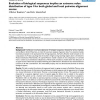886 search results - page 43 / 178 » On the Autoreducibility of Random Sequences |
ICASSP
2009
IEEE
13 years 5 months ago
2009
IEEE
This paper applies two dynamic Bayes networks that include theoretical and measured kinematic features of the vocal tract, respectively, to the task of labeling phoneme sequences ...
ICML
2004
IEEE
14 years 1 months ago
2004
IEEE
We introduce a new perceptron-based discriminative learning algorithm for labeling structured data such as sequences, trees, and graphs. Since it is fully kernelized and uses poin...
ICPR
2008
IEEE
14 years 2 months ago
2008
IEEE
We propose a new method for recovering a 3-D object shape from an image sequence. In order to recover high-resolution relative depth without using the complex Markov random field...
CSB
2003
IEEE
14 years 1 months ago
2003
IEEE
A new and essentially simple method to reconstruct prokaryotic phylogenetic trees from their complete genome data without using sequence alignment is proposed. It is based on the ...
BMCBI
2008
13 years 7 months ago
2008
Background: Confidence in pairwise alignments of biological sequences, obtained by various methods such as Blast or Smith-Waterman, is critical for automatic analyses of genomic d...

